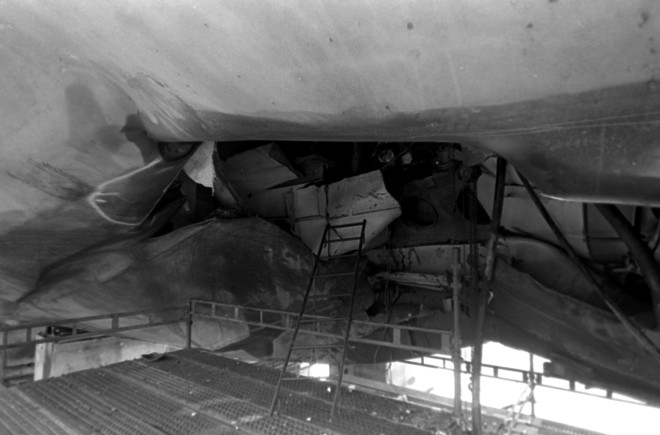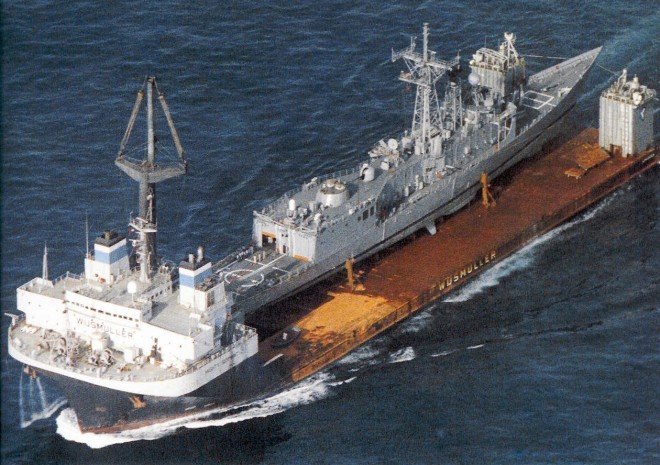
The following is an account of the mine strike on the Oliver Hazard Perry frigate USS Samuel B. Roberts (FFG-58) which originally ran in Proceedings in the April 2013 issue.
In February 1988, the USS Samuel B. Roberts (FFG-58) reported for duty in waters made deadlier by war. The conflict between Iran and Iraq had spread from land to sea, and the United States had pledged to defend Kuwaiti tankers plying the Persian Gulf.
Few ships sailed better prepared. Commander Paul Rinn had pushed his sailors to be the best—to be the New York Yankees, as the Bronx-born combat veteran put it. His commodore had recently named the Roberts the squadron’s top Perry -class frigate; fleet instructors at Guantanamo Bay declared her the best ship they’d seen in years.
On station, the crew discovered that convoy duty was just the public face of Operation Earnest Will. They shooed away Iranian warships and warded off Iraqi fighters, but they also guarded secret mobile operating bases in the northern gulf and launched black Army helicopters on shadowy missions.
Danger was omnipresent. Down in the darkened combat-information center, radar operators sorted seething masses of green specks into tankers and warships, dhows and armed speedboats, airliners and fighter jets. Every dot concealed a different way to die. Less than a year earlier, an Iraqi jet had fired two Exocet missiles into the USS Stark (FFG-31). What Baghdad called a tragic accident, the Roberts took as a bloody warning.
But Rinn worried even more about a threat that didn’t show up on scopes. Since World War II, naval mines had sunk more U.S. warships than missiles, guns, and bombs combined.
On 14 April, the Roberts was heading east in the main shipping channel when a lookout spotted three black spheres in the water. The officer of the deck swiftly brought the frigate to a halt, and someone scratched a log entry: time 1639; position 26 degrees, 22.5 minutes north; 52 degrees, 18.4 minutes east—midway between Qatar and Iran.
In a minefield, the only logical path to safety was the wake. As his ship began to creep backward, Rinn thought, We’re going to get out .
There were those, later, who imagined they heard a scrape of metal on metal—a half-inch-thick hull plate crushing a mine’s foil trigger. Two hundred and fifty pounds of TNT exploded, shaking the Roberts from stem to stern.
The keel snapped, HY-80 steel curling away like pipe cleaner. Superhot gases rushed through a truck-size hole in the hull, setting fires at the ship’s core; a wall of seawater soon followed. The gases vented through the exhaust flues, sending a fireball up through the ship’s stack.
With reflexes instilled by thousands of drills, sailors pulled hoses from passageway racks. But when they opened the nozzles, mere trickles emerged. Somewhere under their feet, something was very wrong. It would take Rinn and his crew hours to add up all the clues, but the early news wasn’t good: The engine room and another capacious engineering space were inundated, and a third compartment was filling rapidly. Lose that one, and the frigate was likely heading to the bottom.

To Chief David Walker, the explosion felt like the worst car accident he’d ever been in. As he picked himself off the deck, the engineer’s gaze flew to gas turbine gauges that showed temperatures skyrocketing over 2,000 degrees. The chief hit switches to dispense flame-suppressing Halon. Nothing happened.
The bad news kept coming. Three of the frigate’s four generators were dead, and the electrical demands of an entire damaged ship quickly overwhelmed the fourth. Five minutes after the mine blast, the Roberts ’ electrical system browned out.
An unaccustomed silence filled the ship, broken only by the shouts of men and the noise of equipment being dragged from repair lockers. And every so often, an unearthly metallic groan emanated from deep within the wounded frigate.
In an instant, the well-ordered engine room that belonged to Chief Alex Perez had become a surreal hell filled with water, flames, and broken machinery. When he regained consciousness, the gas turbine engineer found himself trapped under a metal grate in rising water. Perez gasped for breath, and a superhot mist of smoke, burning oil, and seawater scorched his lungs.
“One minute I was sitting at the console and the next, it was all dark and I was down below,” the chief said later. “I thought I was lost. It was all dark and all I could see was the fire from the burning engine. I thought I was going to drown.”
Fighting the pain from his seared throat, Perez began to yell for help.
Fireman Mike Tilley fixed his flashlight on the big diesel that powered generator no. 1—or had been doing so—and punched the button that was supposed to bring it back to life. No dice. So the engineman striker climbed up onto the engine block and steeled himself for a “suicide start.”
“You have to stand on top of it, and push down on the plunger,” Walker recalled. “Of course, you’re on this 16-cylinder great big huge turbocharged intercooled diesel, and it’s the last place you want to be.”
Tilley put his hand on the plunger. This has to be done , he told himself. Either I start this engine, or the ship and everyone on it dies. Then he brought the lever down.
The engine roared to life. The lights came back on. Another pair of generators soon came back online and, at last, a trio of fire pumps. A quarter-hour after the explosion, the Roberts hose teams finally had water with which to attack the fires.
Deep within the hull, seawater gushed through a dozen cracks in the aft bulkhead of auxiliary machine room 2, one of the ship’s biggest compartments. If AMR 2 flooded—as had the engine room and another auxiliary machine space—the combined load might seal the ship’s fate.
Rick Raymond, an operations specialist and part of the first damage-control (DC) team to descend into AMR 2, wrestled a wooden wedge into a leak and pounded it with a mallet. This was standard DC technique, but the steel bulkhead just split open again. The words of an instructor came back to Raymond: “It only splits like that when there’s a ton of water behind the bulkhead.” Just how bad is it in here? he wondered.
Desperate for softer patches, the DC team began to stuff the leaks with their clothing: chambray shirts, white hats, entire coveralls. Meanwhile, the sailors rigged eductors to suck water out of the bilges and send it over the side. But all the pumps on the ship wouldn’t keep it from rising if the DC team couldn’t find some bigger patches. What, on a ship, was big and soft?
In a moment of inspiration, team leader Kevin Ford—also the ship’s chief cook—sent sailors to fetch pillows and mattresses. They returned with broad smiles and the blue foam bedding from their chiefs’ racks. Raymond folded one of the six-foot cushions, pushed it at a corner leak, and wedged it into place with a wooden beam. It stanched the flow somewhat, and that was progress.
Still, the Roberts kept sinking. Rinn was puzzled; bad as the flooding was, the ship shouldn’t have been riding so low just yet. Then came the shock of realization that his own hose teams were putting ton after ton of water into the skin of his damaged frigate. We’re sinking ourselves!
The captain charged back up to the bridge. Soon the word went out: Stop fighting the fires until further notice. The hose teams could only watch the smoke pour unchallenged from the stack as their rubber boots began to stick to the hot steel deck.
Between the mattresses and the clothing, AMR 2 was beginning to look like the mine had blown up the ship’s laundry instead of the engine room. But more orthodox damage-control gear was also making its way down the ladders: planks and metal beams to hold the soft patches in place. At about 1725, Ford sent word to DC Central that the water was holding six inches below the deck plates: still coming in, but no faster than it was being pumped out.
His team, with help from dozens of shipmates, had kept the Roberts ’ serious wounds from becoming mortal. Now the crew could return to fighting the infection of fire.
Chief Robert Bent, who had heard Perez’ fading cries, returned to the engine room with fellow chief George Cowan and Electrician’s Mate Edwin Copeland. Together they loosened a portion of the grate. Perez ducked under the burning water and pulled himself through submerged wreckage. After several long seconds, he resurfaced and was helped to medical care.
Perez was just one of dozens of sailors injured in the blast. Bill Dodson, another electrician’s mate, was working in the amidships passageway when Larry Welch came hobbling past:
Everyone was yelling and we were moving ammo around or something. Lots of heavy things. And I looked up to see two people escorting GSM Welch aft to the helo deck. He was naked, and completely burned and bloody. He had a gray blanket draped around him. It was a bad scene, and everyone hushed as he walked slowly by. I couldn’t believe he could walk.
After he went by, I think our efforts took on a new sense of urgency.
As darkness surrounded the ship, her crew began to get things under control. Two hours after the explosion, a series of repairs and improvisations finally began feeding a steady stream of water to the firehoses. An hour after that, a daring investigation by Lieutenant Gordan Van Hook, the ship’s chief engineer, and Boatswain’s Mate Eduardo Segovia found the last major fire, deep within the exhaust plenum. Another hour was spent extinguishing reflashes born of the heat stored in thousands of tons of steel.
At 2105, the last of the fires was out.
The Roberts was ultimately towed to Dubai, ferried to Maine, and repaired at a cost of more than $90 million. Still active, she deploys from Mayport, Florida.
The mining and the crew’s fight to save their ship taught—or retaught—important lessons. One is that the more you sweat in peace, the less you bleed in war. Another is that no matter how technologically advanced a military gets, simple weapons can still inflict pain upon it.
The episode also underlines, once again, the bravery, skill, and resourcefulness of American sailors under duress. When Fleet engineers tried to simulate the damage done to the Roberts, they reportedly could not do it without sending their model frigates to the bottom of the tank.
This article was adapted from the author’s book No Higher Honor: Saving the USS Samuel B. Roberts in the Persian Gulf (Naval Institute Press, 2006) .





